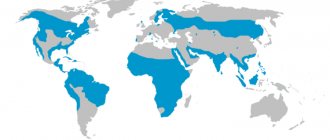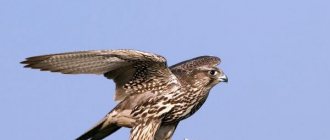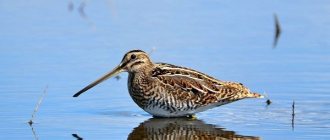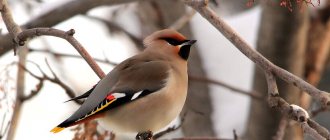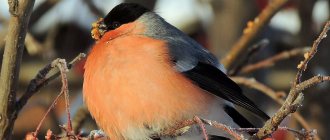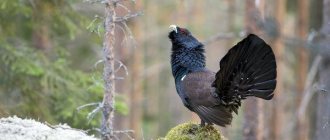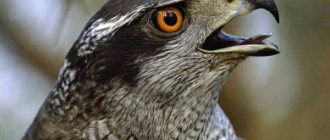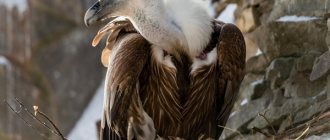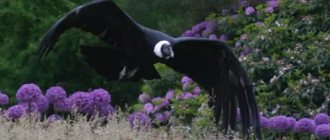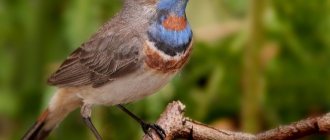Description of species characteristics
The common goldeneye belongs to the duck family. It is considered a medium-sized diving duck.
The description of the species can be presented as follows.
- The duck's body is compact, stocky, with a short neck and a large head for its size. In the crown area the head has a slightly convex shape. This creates a triangular head effect.
- The body length ranges from 42 to 50 centimeters, the wingspan reaches a size range of 64-81 cm.
- The weight of males varies quite widely from 750 to 1245 g. Females are slightly lighter - from 500 to 1182 g.
- The beak for ducks is somewhat unusual - short and high at the base, with a narrow nail.
- Sexual dimorphism in color is pronounced, but not bright. During the period of sexual selection, the male's head becomes black with a metallic green tint. A white round spot forms at the base of the beak under the eye. The iris of the eyes is yellowish, the beak is deep black. The chest, belly and sides are painted white. There is a black and white braid on the shoulders diagonally. The back and tail are black. Both wings are black-brown in color, but there is a large mirror on the secondary flight feathers. The legs are colored orange, the membranes are dark, almost black.
- The female differs from the male in the contrast of color. Her outfit is less contrasting with the predominance of gray and brown shades. The head color is dark brown, but the neck has a narrow white collar. The eyes are also yellow, but the color is not as bright with the presence of an orange band at the top of the iris. The female is smoky gray above, white below.
The common goldeneye belongs to the duck family
The wings are dark with a white mirror, like those of the male. A distinctive feature of the female's speculum is the presence of two white stripes. The female's legs are not so bright. They are more likely to be called dark yellow rather than orange. In summer, sexual dimorphism is somewhat smoothed out, the male loses his spring brightness, as a result of which it can be difficult to distinguish a male from a female.
Habitat
Gogols are migratory birds. For the winter, they fly south or west of their nesting sites, to the coasts of seas and large inland bodies of water.
Common goldeneyes nest in forest zones in Europe, Asia and North America, preferring coniferous forests. Some birds can lead a sedentary lifestyle, but all of them live in northwestern Europe.
The range of Icelandic representatives is scattered. Some are located on the northwestern coast of the North American continent, others are located in Labrador, and are also found in Greenland and Iceland. Birds settle near lakes, bogs and rivers in forest areas.
The small goldeneye has been recorded only in northern North America. During the winter, it migrates to the southern mainland United States and Mexico. Ducks prefer shallow water bodies near mixed forests; they avoid settling in the open tundra.
Gallery: goldeneye bird (25 photos)
Where did the view come from?
Gogol lives in the forests, lakes and rivers of North America, which is considered its homeland, as well as in the Baltic countries and Canada. In Russia, this species is most common in the northern part. In the spring, when the duck breeds its young, it needs an area near water, with many trees, to simplify nesting. In winter, birds try to stay close to bodies of water with non-freezing water.
In ancient books of Kievan Rus, a species of Gogol duck is mentioned. They have long been valued for their soft, warm down, which was widely used on the farm, as well as for the nutritional value of eggs. The collection of gogolin fluff was carried out during a strictly designated period. People got it from nests that birds had already abandoned. To increase the production of valuable raw materials, entire territories were set aside where birds were bred for profit. The business was profitable, many people were involved in it.
Mating season and nesting
Sexual selection occurs based on special sounds that can be mistaken for “singing.” These ducks do not have fights between males, but they do have courtship ceremonies. At this time, the male makes a piercing grinding sound, which is accompanied by a low rattling sound and a hare squeak. The female is not silent, she answers him with an equally “melodic” song - creaking sounds like “berrr-berrr”. In addition, when flying with its wings, the goldeneye produces a high-pitched ringing whistle. This sound is characteristic of many ducks, but in the goldeneye it is ringing and clear.
The goldeneye bird is one of the few ducks that prefer to make their nest in a hollow tree. For this reason, this species is attached to bodies of water surrounded by forest. In order to continue their family, goldeneyes prefer to stay in bays, on the banks of which large and old trees grow.
Ideally, after the mating season, the goldeneye duck finds an old tree with a good hollow. The height of this hollow does not matter. These ducks can place their nest at the foot of a tree, or they can settle at a height of up to 5-7 m. The second is preferable, because at a height the masonry is protected at least from ground predators.
What do they eat?
The diet of the goldeneye duck consists of aquatic invertebrates, which it hunts at the bottom of the reservoir or in the water column. The duck is capable of diving to a depth of 10 meters, but prefers to settle on rivers and lakes with water up to 4 meters.
In winter, birds actively eat these mollusks and crustaceans. In summer, the menu for goldeneye ducks is much more varied. It includes bloodworms (mosquito larvae), midges, dragonflies, caddis flies, water beetles and other insects. Ducks also eat small fish, amphibians and earthworms, collect seeds and roots of plants, and can peck at the green succulent parts of aquatic plants.
We recommend
“Unfasten your seat belts for good.” Documentary film for the 100th anniversary of Alexander Galich11 1041:20:11 “I love drunk women, this is the agony of vanishing youth.” Dmitry Nagiev. The best jokes. Voice-77 66503:01 “Vitya drank heavily and raised his hand against his father,” Elena Proklova about a family conflict. In fact. Fragment of the episode dated 10/19/201818 23801:58 “Give her to me, you are her brother - decide!” - The mentors seriously clashed with each other in the fight for the participant. Voice 7. Fragment of the release dated 10/19/20186 55707:01Basta and Sergey Shnurov sang with the participant. "The wind knows." Voice 7. Fragment of the release dated 10/19/20183 76701:00 Pelageya. "Alfonsina y el mar." Voice 7. Fragment of the release dated 10/19/201865 69706:43 Blind auditions. Voice 7. The best moments of the episode from 10/19/201849 96210:24 “I never forgot about you,” young American women saw their Russian mother for the first time. Let them talk. Fragment of the release from 10/17/201825 34505:11 “I worry and worry about the participants with all my might,” - Yulianna Karaulova about the show “Russian Ninja” 81801:47 “I really liked this Russian Spaniard, he’s so impressive,” - actor Alexander Mikhailov became friends with wife's lover. In fact. Fragment of the release from 10/17/201842 34603:59 Marriage proposal right in the studio! Let them talk. Fragment of the release dated 10/16/201840 89202:21 “He took Maria to the forest, said that “dad needs to be treated for prostatitis,” - the grandmother of the Khachaturian sisters about violence against girls. In fact. Fragment of the release from 10/16/201839 90102:27
Interesting Facts
The unusual coloring of the iris of the eyes, which stand out brightly against the background of the dark plumage of the large head, gave rise to the English name for the beautiful ducks - Common goldeneye. The golden eyes are clearly visible and give the bird an expression of extreme interest. Ducklings' eyes are dark in color, acquiring a characteristic golden color only at the age of 3 months, when they become completely independent.
Ducklings take their first flight at 2 days of age. The hungry mother leaves the hollow and calls the chicks to her with cries. Ducklings jump out of the nest and sometimes fall from great heights, spreading their wings and legs. Most often the landing ends successfully, because the light weight gives the chicks the advantage of a soft landing. Having descended to their mother, they quickly master the water element, learning to look for food during the very first day of their new life. Ducklings will learn to truly fly only at the age of 2 months.
To live in the summer, hatch and raise chicks, goldeneyes choose fairly deep lakes with a large surface of free water, slow rivers, or bodies of water sparsely populated by other birds in a swampy area. The ability to dive deeply and swim some distance under water allows ducks to feed where neither mallards nor long-necked swans can find food. The main diet of goldeneyes consists of aquatic invertebrates, small fish, frogs and tadpoles. They eat algae and near-aquatic plants.
How does the reproduction process occur?
Goldeneyes become sexually mature at the age of two years. Pairs form in the winter quarters or in the spring, during migration to their native nesting grounds.
Having arrived at the place, the drakes begin to chatter and attract attention. First, the black-and-white male stretches his neck, then sharply throws it over his back, raising his beak upward and sharply “jumps” out of the water, pushing off the surface with his paws, raising splashes. Demonstrating its love to the female, the drake opens its tail and makes mating calls.
During the mating season, drakes of the Gogol breed beautifully care for ducks.
The duck lays from 5 to 13 green, fairly large eggs with a brown or blue tint:
- average egg weight - 62 g;
- length 56-63 mm;
- diameter 42-45 mm.
Initially, the eggs are located in a small depression made in the dust accumulated at the bottom of the hollow. During incubation, the duck insulates the bottom and edges of the nest with its own down, twigs, hay, and straw. If the nest has been in use for more than a year, shells from eggs from previous clutches are used to strengthen the walls.
The drake does not take part in incubating the eggs; the clutch is warmed by the female for 29-30 days. In the first 2-3 weeks, the duck leaves the nest for feeding for a short time. But 10 days before the chicks hatch, she does not leave the eggs for a minute.
The dandy daddies do not stay at the nesting site for long; on days 7-9 they fly away for the seasonal molt.
Chicks are born with black backs and white bellies. The first day after hatching they dry out. And the next day, the chicks leave the nest, gliding on their outstretched wings. Having reached the ground, they and the mother duck go to the pond.
Ducklings of the Gogol breed go to the pond already on the second day after birth.
After two weeks, the ducklings already know how to dive and get food on their own. The duck often leaves them completely unattended. Chicks begin to fly on the 57-66th day after birth.
Distribution[edit | edit code]
Nesting range
In flight
North America is considered the homeland of the goldeneye, from where the bird moved first to Asia and then spread throughout the northern hemisphere. The nesting area covers the coniferous forest zone. On the American continent it breeds from Alaska to Newfoundland south to approximately the Canada-US border. In Eurasia, it is distributed east of Switzerland, the states of the former Yugoslavia and Scandinavia, reaching the islands of Sakhalin and Iturup in the east. In the Baltic states, Poland, Germany, the Czech Republic and Great Britain it occurs sporadically (for example, in the British Isles only in the Caledonian Forest region).
To the east, it is more common in northern forests, including in the Siberian taiga. In the European part of Russia it nests to the south to the Yaroslavl, Nizhny Novgorod, Ryazan regions, in Kazakhstan to the south to the mouth of the Ileak, to the east in the north of the country to 53° N. sh., even further east to the south along the Irtysh valley to Lake Zaisan, where the border of the range runs in the region of the Black Irtysh valley, the Tannu-Ola ridge, and the valleys of the Dzhida and Chikoy rivers. Further, the border of the nesting areas enters northeastern China, and then again falls within Russia in the area of the Bolshaya Ussurka River.
Migrations
Nesting biotope - open reservoirs with wooded banks
It is a migratory bird over most of its range; sedentary populations have been recorded only in northwestern Europe. In other cases, it winters to the south and west of the breeding area in the littoral zone of the sea, large lakes, rivers and reservoirs. Populations of the northern regions move mainly by sea. Most of the birds of Northern Europe spend the winter in the Baltic, in the North Sea off the coast of Denmark, the Netherlands and Great Britain, along the coast of Ireland. From more southern regions, as well as from the European part of Russia, birds fly to the eastern part of the Adriatic, to the shores of Greece and the Black Sea, from Western Siberia to the Caspian Sea. In addition, some birds occupy large inland bodies of water in Western and Central Europe. In the Far East, wintering sites are located in ice-free areas of the sea from Kamchatka to China, Taiwan and the Japanese Islands. In North America, birds winter along the west and east coasts, in the Gulf of Mexico and in the Mississippi River valley north to the Great Lakes region.
Habitats
Nesting biotope - fairly large forest lakes, quiet taiga rivers with woody vegetation along the banks (the bird itself is capable of diving up to 10 m, but is usually not found in reservoirs with a depth of more than 4 m), where it is usually concentrated in small bays with vast expanses of open water . In winter it lives at sea, usually in shallow bays, lagoons near rocky shores and sewage outlets, in the estuaries of large rivers, in the south of its range in large inland reservoirs with non-freezing water.
Reproduction of individuals
Puberty of the goldeneye duck usually lasts a long time, about 2 years. In forest areas where birds build nests, they begin to appear in the first month of spring, when the glaciers on the rivers have not melted. Therefore, ducks have to occupy small melt puddles in ponds.
Males and females arrive in pairs or small flocks. Sometimes young animals create a mate for themselves while wintering together. The mating games of birds begin with the enchanting courtship of the male. They put on a whole show for their females, throwing their heads back and flicking their paws through the water.
Drake mating dance
Birds nest in high-rise trees in hollows. Usually their height is up to 12-15 m. Ducks love areas with good visibility. Only in exceptional cases do they nest in a hare hole or an old stump. Usually there are several such nests nearby. Ducks are friendly towards people, especially if they are not disturbed. Sometimes they prefer to settle in birdhouses artificially created by ornithologists.
After choosing a place, they begin to build nests. First, carefully compact the wood dust. And also when building a nest, the female uses her own down. Often such a pair returns to their usual nesting site for several years in a row. In addition, they delimit water territories among themselves.
Read also: Apple jam “Five Minute”: step-by-step recipe, simple and quick from Marina Vykhodtseva
Often ducks prefer artificial “nests”
There are about 10-12 eggs in one clutch, sometimes more, but this is extremely rare. The female incubates the eggs; this process takes about 1 month. During the first days, she is forced to fly away from the nest in order to get food. During its absence, the duck covers the eggs with down. The last 2 weeks before the chicks hatch, does not leave the nest.
Table 1. Characteristics of Gogol duck eggs

